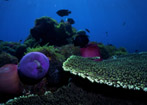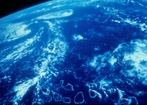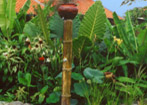Milne Bay, Papua New Guinea
15th
- 22nd March 2006
Sailing was intermittent on the way from the Solomons but we
did make some miles without motor. It was a very beautiful week
at sea.
We arrived into PNG, returning to an isolated submerged reef
that we had dived in 2002. Here we had found a truly pristine
environment, stacked with fish, sharks, healthy corals and behaviours
indicating that the reef was untouched by man. This reef has become
iconic on Heraclitus, representing to us all that a reef
can be when it is left undisturbed. But our return here, three
years later, was ominous.
A fibre glass boat pulled up beside us from an island more than
50 miles away. Their boat was heavily loaded with seven fishermen
and the dead bodies of thirteen sharks. Some of the larger ones
(silvertips) had already had some of their fins removed. These
fishermen are not shark fishing continuously but were on a week
long expedition to this area.
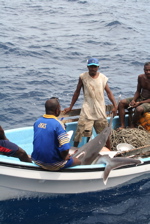
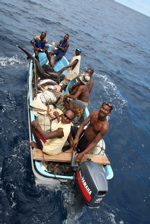
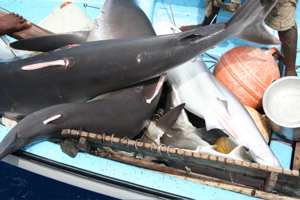
During our dives on the reef, we found a change in the underwater
population. There were still plenty of dogtooth tuna and other
predatory pelagics, but very few sharks. In 2002, the water had
been clear enough for us to see sharks circling around our anchor
chain and the sharks plentiful enough for us to have second thoughts
about swimming. In our Dive Log we wrote:
'Dive aborted because of very large sharks at about 20 metres.
Michel went to investigate - 8 sharks, grey reef and whitetip,
very curious, inspecting him at close range. Unexplored underwater
territory, no divers here, no fishermen. These animals are not
intimidated.'
'All reefs are natural but this reef is nature in its purest
form. The corals are pristine, the fish unphased except for the
smaller prey fish and territorial damsels.'
It's not that this reef is now finished, but it is certainly
not in the untouched state that we left it in three years ago.
On our last dive of the day, Kitty came across three sharks –
juveniles, dead with fins removed.
A mile away at the next-door seamount we were greeted by a much
more exciting underwater scene – swarms of great barracuda
circling around us, big eye trevally in mating circles, sharks
– eight on one dive, five on another (very much alive!),
schools of unicornfish gathering around, several very large Spanish
mackerel and the largest and most plentiful dogtooth tuna we have
ever seen.
In Alotau, we found signs hanging for the purchase of shark fins.
These were not hanging when we were last here in 2002.
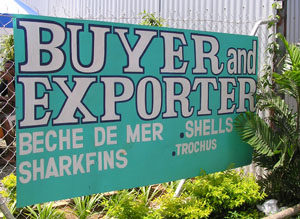
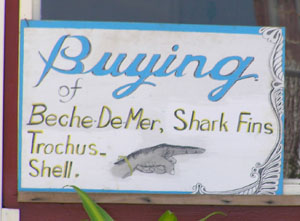
We found Alotau as delightful as we remembered it
- a bustling town filled with islanders from all around Milne
Bay. Bare feet tread the pavements and packages are carried gracefully
on the head. Red shell necklaces adorn and smiles beam at us -
the black ship has returned.

the bustling harbour in Alotau where islanders
congregate to take passage

carrying supplies to the fresh food market
We spent a weekend across the bay from Alotau in Discovery Bay
and watched cyclone Larry zoom across our weatherfaxes, crashing
into Australia with the most intense winds they have felt for
30 years. It was a category 5 cyclone and there were reports of
180 mph winds when it hit land, just south of Cairns. Cyclone
Waita trailed in its wake but stayed kindly offshore.
All this action contrasted strongly with a very peaceful few
days for us, meeting the villagers of Wagawaga. We dived the wreck
of a ship that has developed beautiful coral formations and hosts
an array of interesting ‘critters’ - from the unsuccessful
search for seahorses to the pajama cardinalfish, a juvenile harlequin
sweetlips and some rather aggressive clownfish!
The mountainous slopes are covered in wild forest but it is not
untouched. A joint venture between Malaysia and PNG has stripped
bare several areas visible from our anchorage, persuading landowners
to sell their timber for just 12 Kina (about $US 4) per tree.
We visited the sawmill and saw large old trees stacked up and
ready for processing.
The light at the end of the tunnel was a man called Warren who
has found another way to make money from his mother’s forest
– building an eco-lodge with a backpacker style building
and a beautiful house up the hill, views to die for and a vivid
animal life. Hornbills, pidgeons, parrots, cockatoos flow through
the treetops at dawn and dusk, in large numbers as the forest
begins to disappear around. Butterflies abound.
While here, we listened to stories of an incredible sailing canoe
festival that takes place in Alotau in November. It began only
a few years ago but has already reached national fame, and what
started as a kula region affair has begun to attract sailing canoes
from islands far and wide across PNG. We very much hope to be
back here in time to catch it at the end of this year. Down by
the sea in WagaWaga, canoes from last year’s canoe festival
sit covered in coconut palms. They will be used again in this
year’s races. The tree that they carve into canoes is also
being cleared in the general forestry destruction but it is valueless
to the logging companies and only fit for weatherboard.
Milne Bay was described to us by the Chairman of the festival
as a maritime province. Andrew, from Kitava where we spent a month
in 2002, came to visit us on board also. Old connections renewed,
new connections launched.
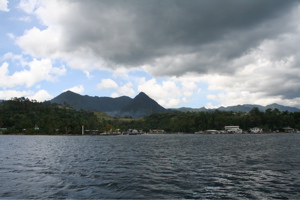
our anchorage in Alotau
|


